

Creative Writing Lesson Plans: Week One
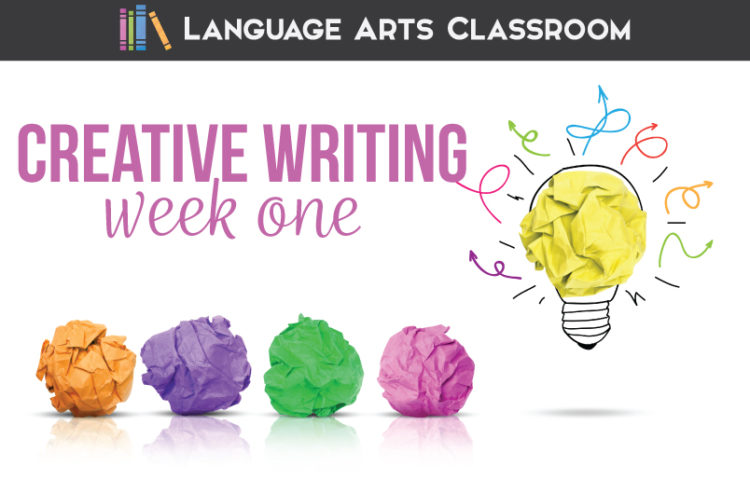
Looking for creative writing lesson plans? I am developing creative writing lesson ideas!
I’ve written and revamped my creative writing lesson plans and learned that the first week is vital in establishing a community of writers, in outlining expectations, and in working with a new class.
What are some good creative writing exercises?
Some good creative writing exercises include writing prompts, free writing, character development exercises, and fun writing games.
The first week, though, we establish trust—and then we begin powerful creative writing exercises to engage young writers and our community.
How can add encouragement in creative writing lesson plans?
I’ve found students are shy about writing creatively, about sharing pieces of themselves. A large part of the first week of class is setting the atmosphere, of showing everyone they are free to create. And! These concepts will apply to most writing lesson plans for secondary students.
Feel free to give me feedback and borrow all that you need! Below, find my detailed my day-by-day progression for creative writing lesson plans for week one.
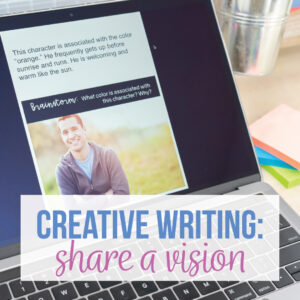
Creative Writing Lesson Day One: Sharing my vision
Comfort matters for young writers. I’m not a huge “ice breaker” type of teacher—I build relationships slowly. Still, to get student writing, we must establish that everyone is safe to explore, to write, to error.
Here are some ideas.
Tone and attitude
For day one with any lesson plan for creative writing, I think it is important to set the tone, to immediately establish what I want from my creative writing students. And that is…
them not to write for me, but for them. I don’t want them writing what they think I want them to write.
Does that make sense? Limitations hurt young writers. My overall tone and attitude toward young writers is that we will work together, create and write together, provide feedback, and invest in ourselves. Older kiddos think that they must provide teachers with the “correct” writing. In such a course, restrictions and boundaries largely go out the window.
Plus, I specifically outline what I believe they can produce in a presentation to set people at ease.
The presentation covers expectations for the class. As the teacher, I am a sort of writing coach with ideas that will not work for everyone. Writers should explore different methods and realize what works for them. First, not everyone will appreciate every type of writing—which is fine. But as a writing community, we must accept that we may not be the target audience for every piece of work.
Therefore, respect is a large component of the class. Be sure to outline what interactions you find acceptable within your classroom community.
Next, as their writing coach, I plan to provide ideas and tools for use. Their job is to decide what tools work for their creative endeavors. My overall message is uplifting and encouraging.
Finally, when we finish, I share the presentation with students so they can consult it throughout the semester. The presentation works nicely for meet-the-teacher night, too!
After covering classroom procedures and rules, I show students a TED Talk. We watch The Danger of a Single Story by Chimamanda Adichie. My goal is to show students that I don’t have a predetermined idea concerning what they should write. This discussion takes the rest of the class period.
Establishing comfort and excitement precedents my other creative writing activities. Personalize your “vision” activities for your lessons in creative writing. Honestly, doing this pre-work builds relationships with students and creates a positive classroom atmosphere.
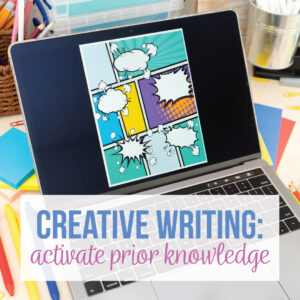
Creative Writing Lesson Day Two: Activating prior knowledge
Students possess prior knowledge concerning creative writing, but they might not consider that. Students should realize that they know what constitutes a great story. They might not realize that yet. An easy lesson plan for creative writing that will pay off later is to activate prior knowledge. Brainstorm creative, memorable, unforgettable stories with students. Share your thoughts too! You will start to build relationships with students who share the same tastes as you (and those that are completely different!).
Activation activity
During this activity, I want to see how students work together, and I want to build a rapport with students. Additionally, activating prior knowledge provides a smooth transition into other creative writing activities.
This creative writing activity is simple:
I ask students to tell me memorable stories—books, play, tv shows, movies—and I write them on the board. I add and veto as appropriate. Normally doing these classroom discussions, we dive deeper into comedies and creative nonfiction. Sometimes as we work, I ask students to research certain stories and definitions. I normally take a picture of our work so that I can build creative writing lessons from students’ interests.
This takes longer than you might think, but I like that aspect. This information can help me shape my future lessons.
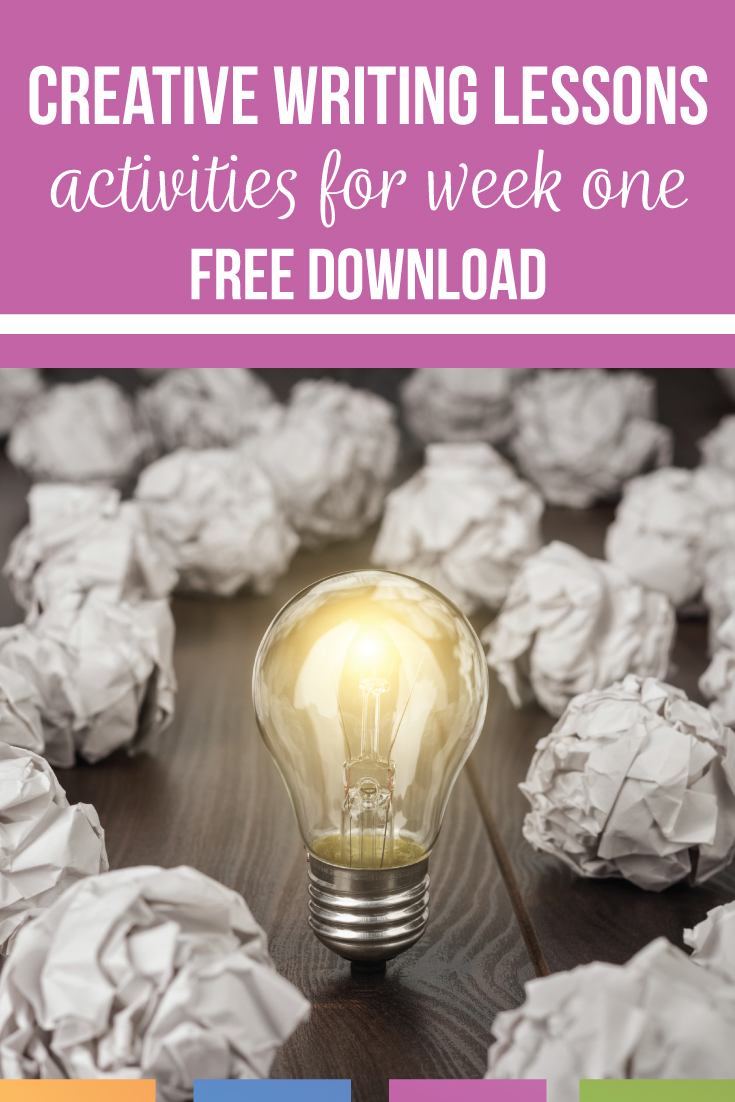
With about twenty minutes left in class, I ask students to form small groups. I want them to derive what makes these stories memorable. Since students complete group and partner activities in this class, I also watch and see how they interact.
Students often draw conclusions about what makes a story memorable:
- Realistic or true-to-life characters.
- Meaningful themes.
- Funny or sad events.
All of this information will be used later as students work on their own writing. Many times, my creative writing lessons overlap, especially concerning the feedback from young writers.
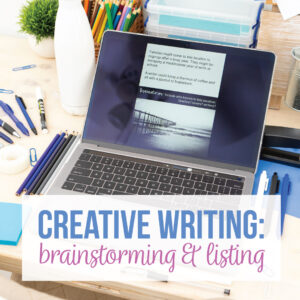
Creative Writing Lesson Day Three: Brainstorming and a graphic organizer
From building creative writing activities and implementing them, I now realize that students think they will sit and write. Ta-da! After all, this isn’t academic writing. Coaching creative writing students is part of the process.
Young writers must accept that a first draft is simply that, a first draft. Building a project requires thought and mistakes. (Any writing endeavor does, really.) Students hear ‘creative writing’ and they think… easy. Therefore, a first week lesson plan for creative writing should touch on what creativity is.
Really, creativity is everywhere. We complete a graphic organizer titled, “Where is Creativity?” Students brainstorm familiar areas that they may not realize have such pieces.
The ideas they compile stir all sorts of conversations:
- Restaurants
- Movie theaters
- Amusement parks
By completing this graphic organizer, we discuss how creativity surrounds us, how we can incorporate different pieces in our writing, and how different areas influence our processes.

Creative Writing Lesson, Days Four and Five: Creative Nonfiction
Students need practice writing, and they need to understand that they will not use every word they write. Cutting out lines is painful for them! Often, a lesson plan for creative writing involves providing time for meaningful writing.
For two days, we study and discuss creative nonfiction. Students start by reading an overview of creative nonfiction . (If you need mentor texts, that website has some as well.) When I have books available, I show the class examples of creative nonfiction.
We then continue through elements of a narrative . Classes are sometimes surprised that a narrative can be nonfiction.
The narrative writing is our first large project. As we continue, students are responsible for smaller projects as well. This keeps them writing most days.
Overall, my students and I work together during the first week of any creative writing class. I encourage them to write, and I cheer on their progress. My message to classes is that their writing has value, and an audience exists for their creations.
And that is my week one! The quick recap:
Week One Creative Writing Lesson Plans
Monday: Rules, procedures, TED Talk, discussion.
Tuesday: Prior knowledge—brainstorm the modeling of memorable stories. Draw conclusions about storytelling with anchor charts. Build community through common knowledge.
Wednesday: Graphic organizer.
Thursday and Friday: Creative nonfiction. Start narrative writing.
Students do well with this small assignment for the second week, and then we move to longer creative writing assignments . When classesexperience success with their first assignment, you can start constructive editing and revising with them as the class continues.

These creative writing activities should be easy implement and personalize for your students.
Would you like access to our free library of downloads?
Marketing Permissions
We will send you emails, but we will never sell your address.
You can change your mind at any time by clicking the unsubscribe link in the footer of any email you receive from us, or by contacting us at [email protected] . We will treat your information with respect. For more information about our privacy practices please visit our website. By clicking below, you agree that we may process your information in accordance with these terms.
We use Mailchimp as our marketing platform. By clicking below to subscribe, you acknowledge that your information will be transferred to Mailchimp for processing. Learn more about Mailchimp’s privacy practices.
Are you interested in more creative writing lesson ideas? My Facebook page has interactive educators who love to discuss creative writing for middle school and high school creative writing lesson plans. Join us!

creative writing creative writing activities
Resources you can trust
- Show all (68)
- (-) English (68)
Subject categories
- All subject categories (364)
- (-) Creative writing (68)
- Writing skills (68)
- Writing for purpose and audience (66)
- English (65)
- Language (65)
- Writing narrative texts (12)
- Arguments and persuasive texts (3)
- Autobiography and biography (3)
- Explanation texts (3)
- Using literary and rhetorical devices (2)
- Adjectives (1)
- Adverbs (1)
- Comparing texts (1)
- Grammar, spelling and vocabulary (1)
- Instruction texts (1)
- Language analysis (1)
- Planning (1)
- Reading skills (1)
- Writing poetry (1)
- (-) All key stages (91)
- (-) All global tags (9)
- Fiction (2)
- Northern Lights (1)
- Oscar Wilde (1)
- Philip Pullman (1)
Resource type
- Worksheet (38)
- Student activity (29)
- Complete lesson (22)
- Teaching ideas (12)
- Exam preparation (3)
- Self-assessment (3)
- Starter/Plenary (3)
- Homework (2)
- Role play/debate/discussion (2)
- Assessment (1)
- Differentiated (1)
- All exam boards (2)
Creative writing
Browse this rich collection of English teaching resources, teaching ideas, templates and creative writing lessons to develop students' descriptive writing, narrative writing and creative writing skills. You'll find compelling picture prompts, supportive word banks and carefully scaffolded resources to engage even the most reluctant of student writers.
There are fun and eclectic lesson ideas, downloadable worksheets and comprehensive PowerPoints for a range of exciting creative writing and short story tasks based on journeys, the senses, on sculpture, on the weather and even 'magical doors'!
Explore point of view, narrative structure and the features of a ‘good story’ as well as how to develop a main character with a range of creative writing tasks to hone students’ descriptive writing skills. You’ll also find resources on using metaphors and similes and varying sentence structure to make their writing more engaging.
Perfect for key stage 3 English classes and GCSE English Language learners.
You might also like our non-fiction writing activities for KS3 English.
Search results
Creative Writing Lesson Plans: From Paragraphs to Narratives
Return from Creative Writing Lesson Plans to Creative Writing Ideas and Activities
Would you prefer to share this page with others by linking to it?
- Click on the HTML link code below.
- Copy and paste it, adding a note of your own, into your blog, a Web page, forums, a blog comment, your Facebook account, or anywhere that someone would find this page valuable.
Helping You Write Across the Curriculum!
copyright 2009-2013 www.creative-writing-ideas-and-activities.com
- Writing Topics
- Writing Prompts
- Writing Ideas
- Writing Activities
- Lesson Plans
- Writing Tips
- Privacy Policy
Our Most Popular Pages
1. Teaching Resources
2. How to Write a Myth
3. February Writing Prompts
4. How to Write a Legend
5. Writing a Personal Narritive
6. Writing Fables
7. Writing Mystery Stories
8. Math Prompts
9. Science Writing Prompts
10. Elements of Persuasive Writing
Recommeded Resources:
AnyWord(TM) Spelling Practice Series!
Worksheets, games and activities to use with any spelling words. Three volumes in all!
Download yours today!
Stop Essay Pain!
LitWorks.com
Resources to help students prepare for literature examinations.
Teach Kids Drama!
- Teach Early Years
- Teach Primary
- Teach Secondary
- Advertise With Us

- New for Schools
- Browse by subject
- Maths & Science
- English & MFL
- Outdoor Learning
- Product Focus
- Resource Guide
Lesson Plan: KS3 English, creative writing
- Subject: English and MFL
- Date Posted: 12 March 2013
- View page as PDF: Download Now

Share this:
Providing the right atmosphere can encourage students to take their creative writing to a whole new level, says Claire Sheffield…
Providing the right atmosphere can encourage students to take their creative writing to a whole new level, says Claire Sheffield…
Today you will….
- Develop the ability to use your imagination to create a story in the gothic genre
- Learn to use ambitious vocabulary to achieve specific effects
Starting a piece of creative writing can be a source of frustration for many young people; so much so that it can lead to loss of confidence. If ideas aren’t flowing, learners can quickly switch off and give up. Creative writing lessons, therefore, need to stimulate all of the senses and inspire students. Creative writing in the gothic genre – spooky stories – offers a wonderful opportunity for just this. This is a topic that always manages to enthuse pupils and one of the most exciting aspects is that the outcome is completely different with every group. Giving students time for thinking and the creation of ideas is essential. Therefore, this plan should be seen as just a starting point; it provides the stimulus from which a number of sessions can be developed. Subsequent periods can also focus on the development of different writing skills as required by the individual needs of a group. As a way into creative writing, this opener allows learners to be independent; an environment that enables them to thrive. Most importantly, it’s a lesson that students always leave talking about!
Starter activity
Creating a spooky word wall.
Preparation is key to this lesson. For maximum impact, everything needs to be ready so that students enter the room and immediately feel a mysterious atmosphere. This can be created by closing blinds, turning off the lights, playing spooky music and displaying an image on the whiteboard of an old, decrepit, haunted-looking house (easily sourced from the internet). It is great to see students entering the room and looking around confused, wondering what is happening and therefore immediately engaged!
Ideally learners need to be seated in small table groups; this should be a buzzy lesson with lots of group discussion and sharing of ideas. As they take their seats they see on their table a map/floor plan of a house with a cross in one of the rooms; it’s one of the rooms from the house displayed on the board. This can be easily created in a word document using text boxes to create the floor plan and labelling each room. The idea is that each table will focus on a different room.
On each table an instruction card for the starter activity is also displayed. This should say something along the lines of: ‘As a group create a word wall of spooky words to describe the room you are in. Be as ambitious as possible! You have 5 minutes’. This could be completed on A3 paper or on post-it notes to stick up on the wall next to them; students will then have created their own bank of vocabulary that will help them in later parts of the lesson.
Main activities
1 developing the plot.
This lesson works well if very little is said by the teacher to the whole class. This adds to the mysterious atmosphere because students have to read and find out what to do at different stages. The teacher very much facilitates the learning in this lesson, by circulating the room, supporting and stretching groups as appropriate.
As the 5 minutes for the starter activity draws to a close, the spooky background music should be turned off and a short, shocking sound should be played. This could be a scream or a crash, for example. As this point another slide should be displayed on the board to move students onto the next stage of the lesson. This could read: ‘What has happened? Write the opening for a spooky story about a mysterious incident that has happened in the room you are in. Discuss for 5 minutes.’ Students are now using their imaginations to create a plot for their gothic story; it is important that students are encouraged to discuss and develop ideas before beginning the writing stage.
2 Going further
After around five minutes discussion, another slide can be displayed which reads: ‘Look for a clue about what has happened. You will find this somewhere near you!’ Underneath each table, students will find an envelope with a picture of a clue. This could be anything (e.g. a book or a camera). Equally, props could be placed around the room for students to find. The more unusual the better! It just gets pupils thinking more creatively. They will naturally want to talk about what they have found and start to revise their previous thinking
3 Stage three
After a few moments, the final slide of instruction can be displayed. This time, students are told: ‘Time to start writing. You have 25 minutes to use the clues so far to write the opening to a spooky story. Remember your objectives – be imaginative and use ambitious vocabulary to achieve a spooky effect.’ Spooky background music can be played throughout the writing stage. It is also important that learners have access to a thesaurus in order to locate more ambitious vocabulary.
Home learning
The lesson can be used as a starting point and developed in a number of ways… + Subsequent lessons/home learning activities could focus on developing other writing skills such as structuring a plot from beginning to end, using literary devices or using a variety of sentence structures and punctuation for effect.
+ The written work could lead into a speaking and listening lesson where students devise, rehearse and perform dramatic readings of their stories. + Students can explore a variety of gothic literature, researching different writers in the genre, reading different works and learning about the conventions of the genre. They can then develop their work to incorporate more of these conventions themselves.
After the main writing stage of this lesson, students are usually desperate to read their work out. To be able to do this in a meaningful way though, more time is usually needed, so it is appropriate to dedicate the following lesson to this. However, an opportunity to share work with others can be achieved through groups swapping their work and providing some feedback to consider for the following lesson. Questions such as those below can help students to structure their feedback in a constructive manner:
- How imaginative is the piece?
- How exciting did you find the story?
- Is there anything that does not make sense?
- How ambitious is the vocabulary? Does it achieve the desired spooky effect?
- How would you like the group to improve the piece?
- What questions can you ask the group to help them develop the piece further?
The following lesson can then begin with students considering this feedback in order to improve the work they have begun in this lesson.
Differentiation suggestions to support less able students:
- Provide a word bank or sentence starter bank.
- Provide additional resources to inspire ideas; further images or props, for example.
- Provide a wagoll (what a good one looks like) as a model of a piece of spooky writing.
- Suggestions to stretch more able students:
- Provide definitions/examples of literary devices and a challenge card asking students to ‘aim to include as many literary devices as possible.’
- Ask students to work towards a third learning objective: ‘use a variety of sentence structures for effect’ or ‘use a variety of punctuation for effect.’
- Allocate an expert to mixed ability groups who is asked to fulfil additional responsibilities as group leader.
- Provide a ‘challenging criteria’ card as a checklist of skills that more able students should aim to demonstrate.
You may also be interested in...
- Strictly 1000 Words winners chosen after enthralling live finals
- 1000 Word Challenge surpasses 10,000 learners
- CHOOSE KIND
Subscribe to Our Newsletter
I agree to the Terms & Conditions and Privacy & Cookies Policy.

Recommended for you...

Lesson Plan: KS3 English, Dickens
English and MFL

Make touchscreen technology work for you

Inspire students with a touch of magic

How To Keep Your Students Safe Online
Browse by Secondary Subject

Creative Writing - Teaching Resources
BBC Teach > Educational Calendar
Everyone has a story to tell and sharing it can be a source of pleasure and power. Inspire your pupils and help them sharpen their creative writing skills with this collection of classroom resources for primary and secondary schools.
What is National Writing Day?
National Writing Day is an annual day dedicated to celebrating and practising creative writing for pleasure and self-expression.
These resources could be used to celebrate National Writing Day , which takes place on Wednesday, 19 June 2024 .
Primary resources
Musical Storyland. collection Musical Storyland
Journey through Musical Storyland, where children’s favourite fairy tales and traditional folktales are re-imagined with magical music performed by musicians of the BBC Philharmonic Orchestra.
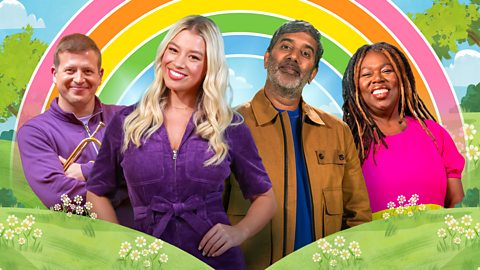
Creative art, design and writing skills. collection Creative art, design and writing skills
A series of short films for primary schools exploring creativity in art and design and creative writing.
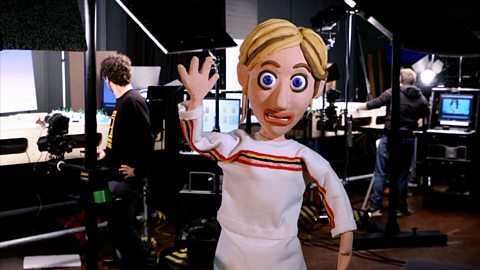
Super Movers KS1 English Collection. collection Super Movers KS1 English Collection
Song and movement routines covering grammar rules, prefixes and suffixes, the alphabet and more!
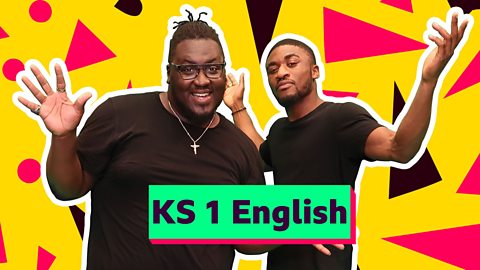
Super Movers KS2 English Collection. collection Super Movers KS2 English Collection
KS2 English videos covering topics including conjunctions, homophones, misspelt words and noun phrases.
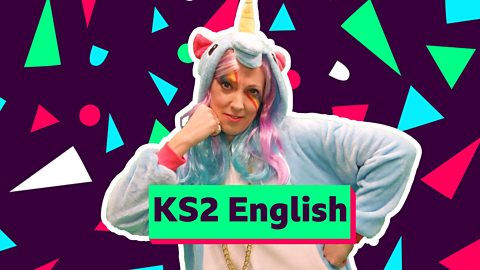
Understanding Poetry. collection Understanding Poetry
In this series of short films Joseph Coelho explains how poetry is relatable, fun and achievable, and can open up new ways of understanding and expressing emotions and thoughts.
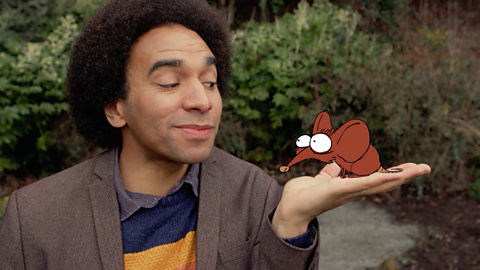
Beano - How to create a comic. collection Beano - How to create a comic
Three classroom videos produced in partnership with Beano in which Mike Stirling (Beano's 'Director of Mischief') and his team of comic creatives offer primary pupils their expert tips and advice on comic creation.
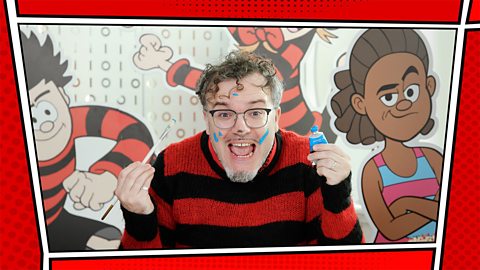
Primary Live Lessons
Watch again: World Book Day 2024 – Live Lesson. video Watch again: World Book Day 2024 – Live Lesson
Maddie Moate and Joe Tasker are joined by some amazing authors as we celebrate World Book Day by creating our own Live Lessons' pop-up library.

Watch again: 500 Words 2023 – Live Lesson. video Watch again: 500 Words 2023 – Live Lesson
We celebrate the relaunch of 500 Words with a 500 Words Live Lesson for primary schools.
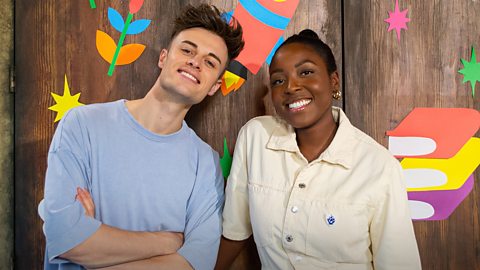
Watch again: Remembrance – Literacy Live Lesson. video Watch again: Remembrance – Literacy Live Lesson
We look ahead to Remembrance Day in this thought-provoking literacy Live Lesson for 7-11 year olds.
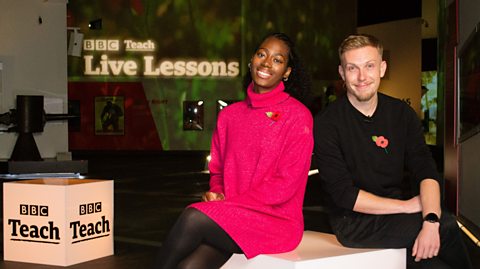
Watch again: Literacy Live Lesson 1 for 5-7 year-olds. video Watch again: Literacy Live Lesson 1 for 5-7 year-olds
Rhys Stephenson and Mr Smith explore the book Simon Sock by Paul Linnet and Sue Hendra and learn about using capital letters, discuss what makes a good friend and write about their own hobbies.
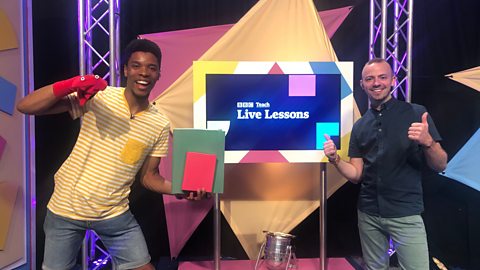
Watch again: Literacy Live Lesson 1 for 7-11 year-olds. video Watch again: Literacy Live Lesson 1 for 7-11 year-olds
Chris Johnson and Mrs Vee from Bitesize Daily explore the damage that plastic is causing to the environment and learn how to write a slogan, explore different styles and forms of writing, and create a poster about tackling plastic waste.
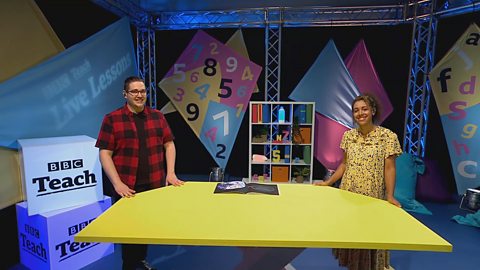
Watch again: Literacy Live Lesson 2 for 5-7 year-olds. video Watch again: Literacy Live Lesson 2 for 5-7 year-olds
Using poems from Michael Rosen’s A Great Big Cuddle collection, Rhys and Mr Smith study rhyming, adjectives and nouns. Your pupils can try creating a character and writing some verses about them, and will learn about rhyming structure.
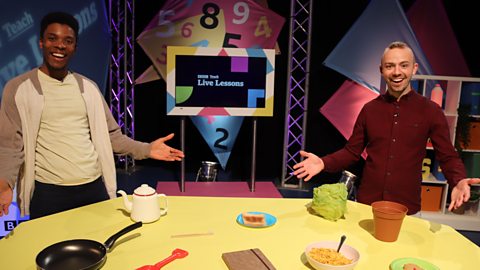
Watch again: Literacy Live Lesson 2 for 7-11 year-olds. video Watch again: Literacy Live Lesson 2 for 7-11 year-olds
Ayshah Tull and poets Mark Grist, Rachel Rooney, Harry Baker and Levi Tafari explore different styles and structures of poetry writing. There’s even an exclusive poem from Mark himself for the Live Lessons audience.
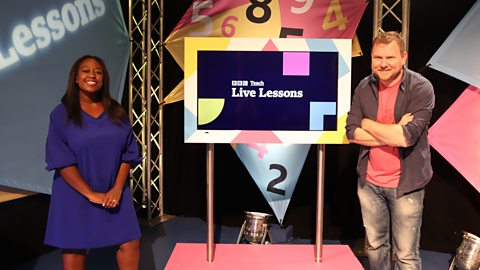
Watch again: Literacy Live Lesson 3 for 5-7 year-olds. video Watch again: Literacy Live Lesson 3 for 5-7 year-olds
Rebecca Keatley and Mr Smith from Bitesize Daily read 'The Tale of a Toothbrush', explain how to write questions, explore alliteration, and investigate how we can help to protect the environment.
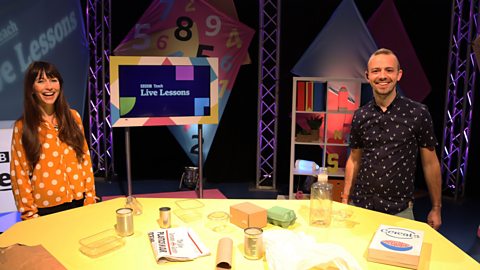
Watch again: Literacy Live Lesson 3 for 7-11 year-olds. video Watch again: Literacy Live Lesson 3 for 7-11 year-olds
Ayshah Tull and Mrs Vee explore the inspirational lives and contributions of black writers, musicians, activists and more. Together with guest readers Angelica Bell and David Lammy, they explain how language is used in songs and speeches to inspire us, demonstrate the importance of proof-reading, and challenge pupils to write about their dreams for a better world.
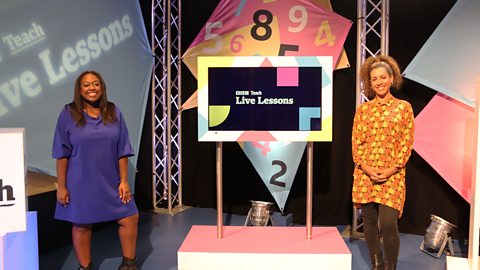
Watch again: Literacy Live Lesson 4 for 5-7 year-olds. video Watch again: Literacy Live Lesson 4 for 5-7 year-olds
Rhys Stephenson and Mr Smith read Unplugged by Steve Antony. They investigate prefixes, explore what it means to be a good friend using adjectives, and create characters. There's even a draw-along with writer and illustrator Steve Antony!
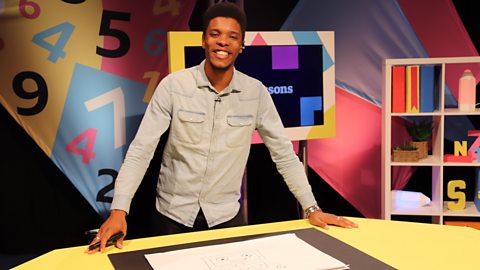
Watch again: Literacy Live Lesson 4 for 7-11 year-olds. video Watch again: Literacy Live Lesson 4 for 7-11 year-olds
Ayshah Tull and Mrs Vee go on a quest, exploring the world of Philip Pullman’s trilogy ‘His Dark Materials’. With interviews from cast members of the TV series, Ayshah and Mrs Vee take a look at the characters and magical themes in the books.
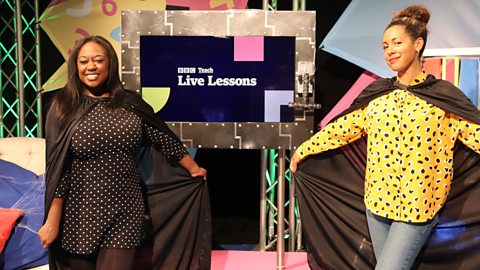
Watch again: Literacy Live Lesson 5 for 5-7 year-olds. video Watch again: Literacy Live Lesson 5 for 5-7 year-olds
This animal-themed English lesson sees Rebecca Keatley and Mr Smith read through a biography of Jane Goodall. They explore Goodall’s life as an anthropologist and learn about adjectives, verbs and adverbs.
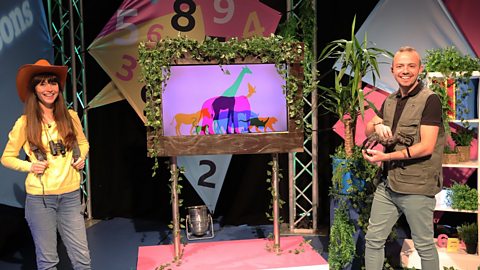
Watch again: Literacy Live Lesson 5 for 7-11 year-olds. video Watch again: Literacy Live Lesson 5 for 7-11 year-olds
Ayshah Tull and Mrs Vee look at the book Battle Bunny, learn how to edit text, and look at blackout poetry and graffiti along the way. Guest readings from the book's authors inspire pupils to develop their own characters and to use a range of words in their writing by thinking about synonyms and antonyms.

Watch again: CBeebies: Stories by the Sea - Live Lesson. video Watch again: CBeebies: Stories by the Sea - Live Lesson
This interactive lesson explores storytelling techniques for 5-7 year-olds with CBeebies friends from Old Jack's Boat.
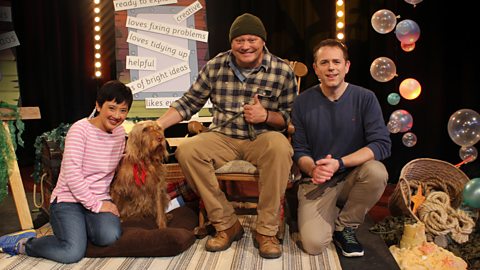
Watch again: Roald Dahl Day lesson - The Power of Words. video Watch again: Roald Dahl Day lesson - The Power of Words
Watch our celebration of Roald Dahl Story Day with this special interactive lesson for pupils aged 7 to 11.
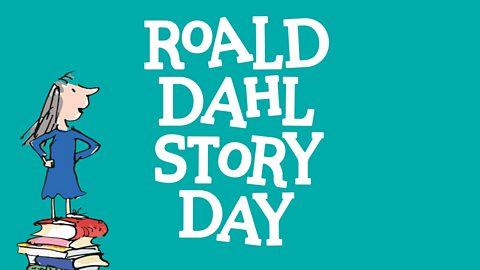
Secondary resources
Inside the Writer's Mind. collection Inside the Writer's Mind
Created in partnership with First Story, these short films for secondary schools offer insights into the ideation and creative writing processes of contemporary writers working across a number of genres. From playwrights to poets via children's authors and graphic novelists, each short film follows a real writer's journey – from how they find their inspiration and work with a stimulus, to how they edit and perform a written piece.
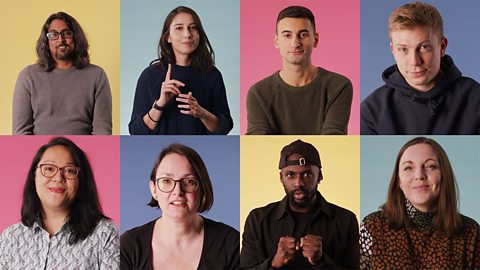
Curriculum Collections: English Literature / Language. collection Curriculum Collections: English Literature / Language
Anthony Horowitz introduces clips from the BBC archive featuring famous faces including Stephen Fry, Kate Humble and Griff Rhys Jones.
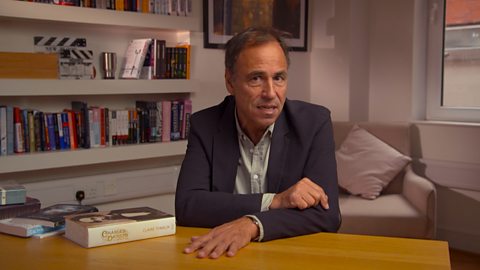
Young Reporter Live Lesson. video Young Reporter Live Lesson
Ever wondered what skills you’d need to take on a career in journalism? Look no further! This 30-minute Live Lesson for 11-14 year-olds will introduce you to writing for a range of purposes and audiences, and how to enhance the impact of your writing through storytelling.
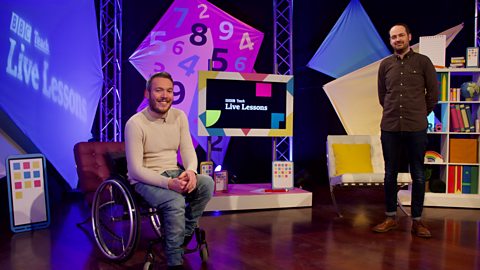
GCSE English Language. collection GCSE English Language
A series of short films designed with the English Language GCSE curriculum in mind and intended to support students.
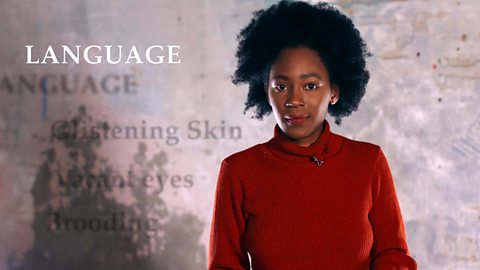
BBC Young Writers' Award - Teaching Resources. collection BBC Young Writers' Award - Teaching Resources
The BBC Young Writers’ Award with Cambridge University invites young people in the UK aged between 14 -18 years to submit short stories of up to 1,000 words. To inspire your pupils and help them to create their entries, we’ve created this collection of resources all about short stories.
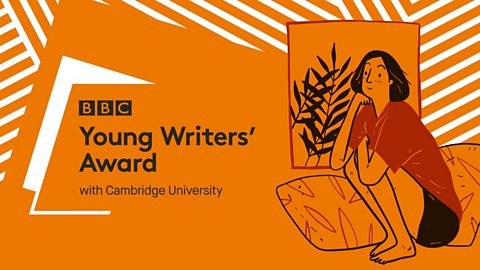
Creative Writing Lesson Plans
- Most Popular
- Most Recent
| Add to Folder | |
|---|---|
| creative writing | |
| children's book | |
| activities | |
| classroom tools | |
| language arts and writing | |
| vocabulary |


Lesson Plan on Creative Writing
by B.S. Selina | 25 May 2021
The lesson plan on creative writing is for UG students of I year who are at an Intermediate level of language proficiency which is part of course work for students of semester-I. The lesson plan is in PPPP format.
Resource Type: Lesson Plan
Audience: University
Audience Language Proficiency: Intermediate
Duration: 60 minutes
Notebook, pen, smart phone/camera
Writing skills with specific reference to creative writing
Students will demonstrate an understanding of creative writing and will be able to write on any topic chosen by them.
1. Introduction on creative writing is to be given to students as they have no previous knowledge of the topic
2.As a warm up activity, students will be asked to attempt free writing on a given topic. This will create confidence in them that they can attempt writing tasks.
3. The warm up activity is, however, not assessed.
4. To begin the creative writing task through use of photography, students need to be given notice, one week in advance to click three pictures on anything that interests them on their smart phone or a camera, if they do not possess a smart phone.
5. They can then be given a choice to select one of the pictures taken and write on it. This will create interest in the student as they can relate to it.
6. The teacher can take time to assess the students as it takes time to go through them.
The teacher goes through the work of the students and by the next class, she will give valuable and overall feedback for the work of each student as follows:
- Very well-written
- Well-organized and presented. But there are some spelling mistakes
- Well done but punctuation should be taken care of
- Good attempt but certain sentences can be rewritten to make the writing effective
The teacher will then select well-written and exceptional work which will be made available on the LMS platform to encourage students to write better.
http://d2lq260uvblqf7.cloudfront.net/convention/2012/sessions/160/default.htm
Supporting Files: Lesson Plan On Creative Writing.pdf
TESOL Interest Section: English as a Foreign Language
This website uses cookies. A cookie is a small piece of code that gives your computer a unique identity, but it does not contain any information that allows us to identify you personally. For more information on how TESOL International Association uses cookies, please read our privacy policy . Most browsers automatically accept cookies, but if you prefer, you can opt out by changing your browser settings.
The Mysteries of Harris Burdick : Using Illustrations to Guide Writing

- Resources & Preparation
- Instructional Plan
- Related Resources
Mysteries are a great way to hook students into writing about fictional happenings. In this lesson, students engage themselves in The Mysteries of Harris Burdic k by examining the illustrations in the book and choosing one for which to create a Mystery Cube and then a creative writing piece. Finally, students present their mysteries to the class and allow students to guess to which illustration their mystery corresponds.
Featured Resources
- The Mysteries of Harris Burdick by Chris Van Allsburg (regular or portfolio/poster-size edition)
- Mystery Cube : This tool is used to help students develop outlines for their own mystery stories.
From Theory to Practice
In "Literacy in the Arts," Peggy Albers argues that "if we want children to represent meaning visually, musically, and/or dramatically, along with their written texts-in other words, to create a semiotic system-we have a responsibility to teach them how to create meaning in many sign systems" (8). Albers' work provides useful theoretical background to support offering students the opportunity to connect art, existing text, and their own writing in the classroom.
The NCTE Position Statement on Multimodal Literacies supports Albers' claims, noting that the "[i]ntegration of multiple modes of communication and expression can enhance or transform the meaning of the work beyond illustration or decoration." The implication for teachers and the students in their classrooms is the need to study and produce an "interplay of meaning-making systems."
Further Reading
Common Core Standards
This resource has been aligned to the Common Core State Standards for states in which they have been adopted. If a state does not appear in the drop-down, CCSS alignments are forthcoming.
State Standards
This lesson has been aligned to standards in the following states. If a state does not appear in the drop-down, standard alignments are not currently available for that state.

NCTE/IRA National Standards for the English Language Arts
- 1. Students read a wide range of print and nonprint texts to build an understanding of texts, of themselves, and of the cultures of the United States and the world; to acquire new information; to respond to the needs and demands of society and the workplace; and for personal fulfillment. Among these texts are fiction and nonfiction, classic and contemporary works.
- 3. Students apply a wide range of strategies to comprehend, interpret, evaluate, and appreciate texts. They draw on their prior experience, their interactions with other readers and writers, their knowledge of word meaning and of other texts, their word identification strategies, and their understanding of textual features (e.g., sound-letter correspondence, sentence structure, context, graphics).
- 4. Students adjust their use of spoken, written, and visual language (e.g., conventions, style, vocabulary) to communicate effectively with a variety of audiences and for different purposes.
- 5. Students employ a wide range of strategies as they write and use different writing process elements appropriately to communicate with different audiences for a variety of purposes.
- 12. Students use spoken, written, and visual language to accomplish their own purposes (e.g., for learning, enjoyment, persuasion, and the exchange of information).
Materials and Technology
- Computers with internet access
- Mystery Cube Planning Sheet
- Editing Checklist for Self- and Peer Editing
- Mystery Writing Rubric
This learning activity helps students write a mystery step by step by following tips and suggestions from writer Joan Lowery Nixon.
This official site for the book includes a message from the author, Chris Van Allsburg, Readers’ Stories, and Tips for Writers.
Chris Van Allsburg’s author site includes a look inside the book, teacher resources, and a kids’ corner, as well as information about Van Allsburg and his other works.
Preparation
- Locate The Mysteries of Harris Burdick in your classroom library, your local library, or a bookseller. Familiarize yourself with the content and the images within the book.
- Test the Mystery Cube student interactive and make sure that you have the appropriate software installed for it to run effectively. You will need computers with internet access for each student to use this interactive. If computer accessibility is a problem, print a copy of the Mystery Cube and make enough copies for each student. If you need additional help with this interactive, please visit our Technical Help page .
- Make enough copies of the Mystery Cube Planning Sheet and the Mystery Writing Rubric for each student.
Student Objectives
Students will:
- focus on illustrations within a book to help spark their imagination and ideas for creative writing.
- develop their creative writing skills to plan, draft, edit, and write a final version of a mystery.
- present their mystery to other students in the class for feedback and discussion.
Session One
- Introduce students to the idea of mystery and have a class discussion about mysteries that your students have read, written, or tried to solve.
- Explain to students that today they’ll be learning about The Mysteries of Harris Burdick and trying to solve the mysteries within the book.
- Begin reading the book aloud to your students, beginning with the Introduction. After finishing the Introduction, read page-by-page through the book, pausing to show the pictures on each page and reading the title and caption that go with each image. You may choose to display large, poster-size images from the book, which are available in the portfolio edition of The Mysteries of Harris Burdick .
- Allow students to comment about each picture and caption as you read the book aloud to help spark their imagination for the writing they will be doing.
Session Two
- Explain to students that their job as detectives is to unravel the mystery from one of the pictures in this story. They must write a creative mystery that goes with an image of their choosing from the book.
- Tell students that once their stories are written, they will be read aloud to the class and the other students will be responsible for figuring out which image from the book their story represents.
- To prepare for writing, introduce students to the Mystery Cube student interactive. This tool will be used to help students develop outlines for their own mystery stories.
- Complete a Mystery Cube as a class to familiarize students with the tool and what is expected of them. Allow the class to choose one of the images in the book (and the caption that goes with it) for which to create the class Mystery Cube .
- Allow time for students to peruse the images in the book and/or the larger portfolio images to read the captions and decide on which image they’d like to write about. After students have decided on an image to write about, they should begin brainstorming ideas for their story and using the Mystery Cube Planning Sheet to flesh out their ideas. They will use this information to create their Mystery Cube in the next session.
- If the Mystery Cube Planning Sheet is not completed during the time allowed, it needs to be finished out of class in preparation for the next session.
Session Three
- Take students to the library or computer lab and allow time for them to create their own Mystery Cube based on one of the stories from the book. Make sure students have their Mystery Cube Planning Sheet from the previous session to help guide them. If computer access is not readily available, you could print out the cube (prior to this session) and provide each student with a paper copy on which to write.
- Remind students to print their Mystery Cube when they are finished. This interactive is not able to be saved on the computer.
- Allow time for students to assemble their Mystery Cube . These will be used in the next session to help guide students as they begin their story writing.
Session Four
- Before starting the writing process, share the Mystery Writing Rubric with students and discuss how it will be used to assess their writing. Using the class Mystery Cube as a guide, write a short mystery as a class. This can be done on a computer (to be projected onto a screen), or written directly on an overhead projector.
- To show the how the students will be graded on their own mysteries, use the Mystery Writing Rubric to grade the rough draft that the class created together. Go through each section step by step and ask for/allow student input on what the score should be and why.
- Students should now understand what is expected of them for this writing assignment. They will begin writing their own mystery in the next session.
Session Five
- Students may begin writing their own mystery story. They should use their Mystery Cube and the Mystery Writing Rubric for guidance as they write.
- Once students are done with their first draft of their story, they may begin self-editing and peer-editing. They may use the Editing Checklist for Self- and Peer Editing to assist them and a partner when they are ready to edit.
Session Six
- Allow students to finish their self-editing and peer-editing from the previous session, using the Editing Checklist for Self- and Peer Editing . After their stories have been edited by themselves and a peer, students may begin writing their final draft of their mystery story.
- Their final draft should be completed prior to the next session. When students have completed their final draft, they should turn in their rough draft, completed Editing Checklist for Self- and Peer Editing , and their final draft for the teacher to check for completion of all of the steps. Return each student’s story to him/her before the next session begins.
Session Seven
- Display the images from The Mysteries of Harris Burdick in front of the class if you have poster-size images, or display one or more copies of the book.
- Organize a class read-aloud where each student is given the opportunity to read his/her story aloud to the rest of the class. Allow the other students in the class time to discuss/comment on each story and decide which image/caption from The Mysteries of Harris Burdick it belongs to.
- Use the Mystery Writing Rubric to assess students' creative stories and attention to detail.
- Have students create their own Stapleless Book that is full of mysterious images and corresponding captions. Students could then write stories to go with these images and captions, much as they did in the lesson.
- Around Halloween time, have a classroom spook-session! Invite other students and family members to come to your classroom for read alouds of the students’ mysteries. Try reading these stories in the dark with only a flashlight and decorating your classroom like a haunted house!
- Have students submit their stories to the Houghton Mifflin’s Harris Burdick Book Site . New stories are posted each month, and periodically writers are selected at random to receive books autographed by Chris Van Allsburg and other Burdick-inspired items.
Student Assessment / Reflections
- Assess students’ participation in the creation of their Mystery Cube by checking to see if all areas of the cube are completed.
- Collect students’ rough drafts, completed Editing Checklist for Self- and Peer Editing , and their final drafts to check for completion of all of the steps.
- Use the Mystery Writing Rubric to assess their creative story and attention to detail.
- Calendar Activities
- Lesson Plans
- Student Interactives
Mysteries are shared with students for them to solve and brainstorm the attributes of a good mystery. Small groups then compose short mysteries using the Mystery Cube.
Students read and discuss an award-winning book before writing their own story that demonstrates compassion.
Students track the elements of mystery stories through Directed Learning-Thinking Activities, story maps, and puzzles. Then they offer clues for other readers as they plan and write original mystery stories.
The interactive Cube Creator helps students identify and summarize key elements. It can be used as a prewriting or postreading activity.
The Mystery Cube helps students identify and summarize story elements in this popular genre. It can be used as a postreading or prewriting activity.
Add new comment
- Print this resource
Explore Resources by Grade
- Kindergarten K

6 Creative Lessons to Inspire Secondary Writers
Looking for outside-the-box ELA teaching ideas? This roundup from TeachWriting.org has valuable ideas for everyone, covering everything from differentiation ideas…to engaging mini lessons…to maker spaces…and more!
Let’s dive into the ideas linked below to find inspiration you can use to engage middle and high school students. Here are six different posts containing creative lessons, resources, and activities to inspire secondary writers.
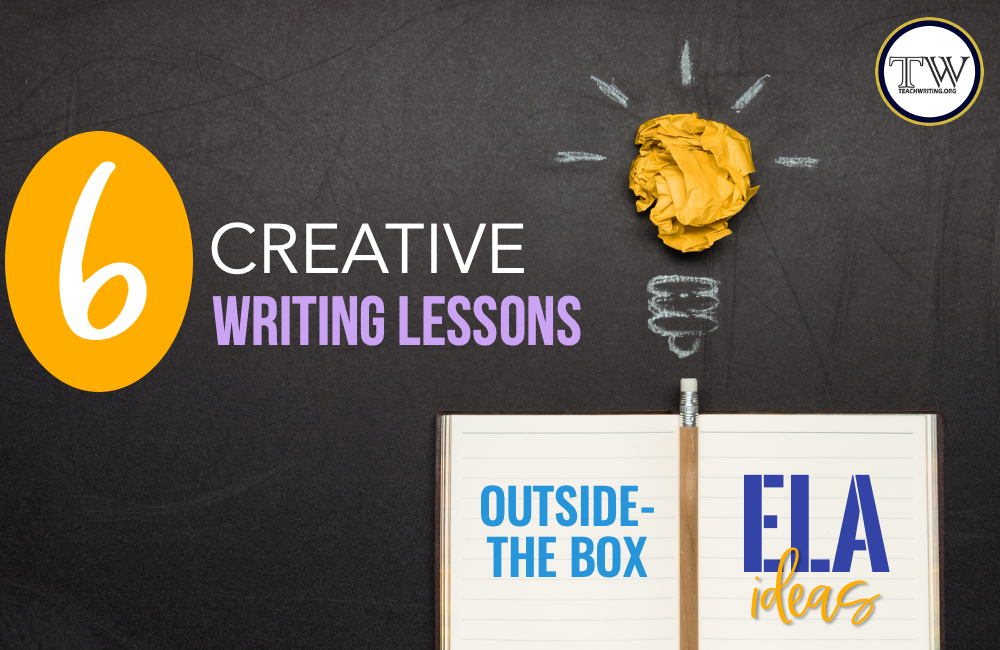
PICTURE-INSPIRED POETRY
Read about THIRTEEN ways Reading and Writing Haven uses pictures to inspire students to write poetry . Heading into a literary analysis, poetry, or creative writing unit? These ideas will be especially useful!
Ready to dive into poetry analysis and written response? Add some zest to your typical lesson plan with this visual one pager that scaffolds students analysis of key poem or song elements.
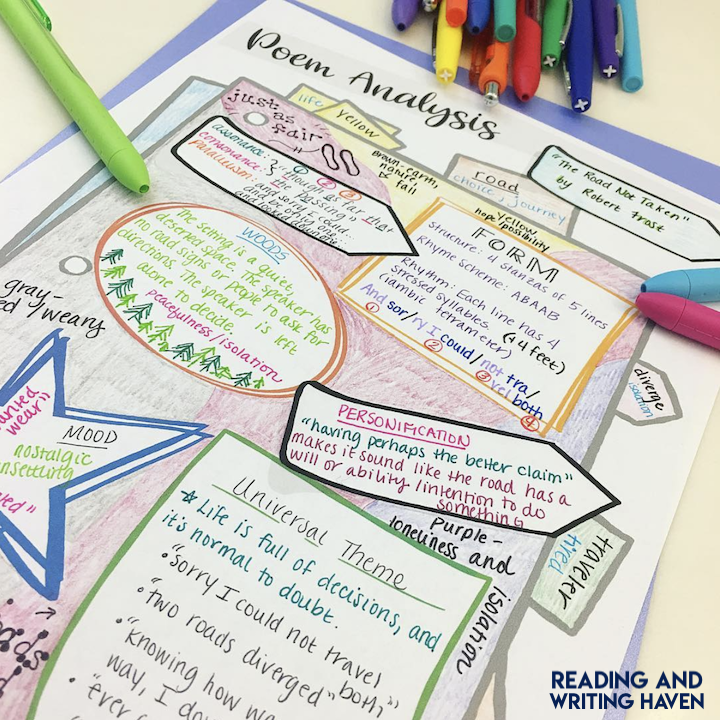
Scaffolded poetry analysis one pager from Reading and Writing Haven
SUSPENSE WRITING
In this post, Teach BeTween the Lines shares FOUR mini-lessons for teaching suspense writing , including character analysis, sensory images, literary devices, and more.
Dive into a spooky-type short story and character analysis with “The Most Dangerous Game.”
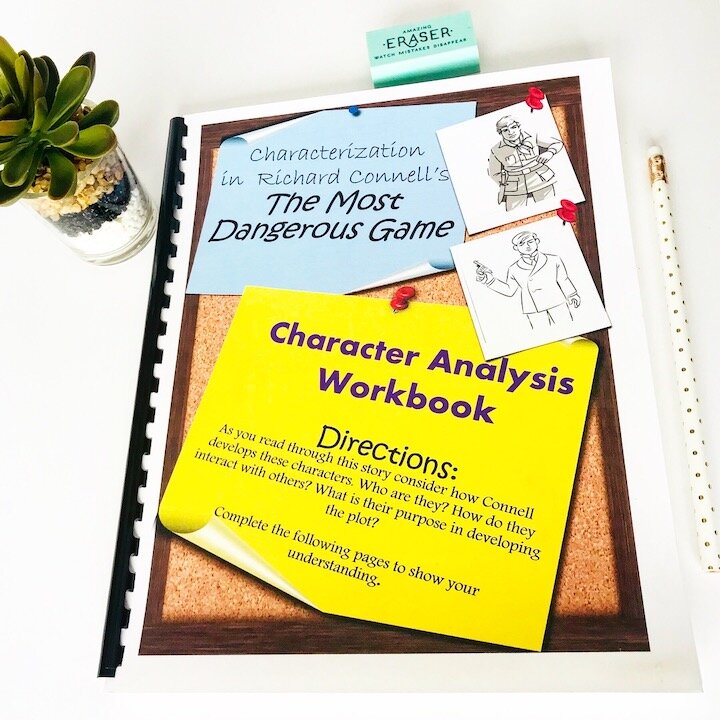
“Most Dangerous Game” Character Analysis Workbook from Teach BeTween the Lines
MAKER SPACE
This creative lesson to inspire secondary writers is a newer approach . Turn your writer’s workshop into a maker space with these unique ideas from Spark Creativity.
It’s true! Creative writing doesn’t have to be intimidating. Engage students with this short story maker assignment .
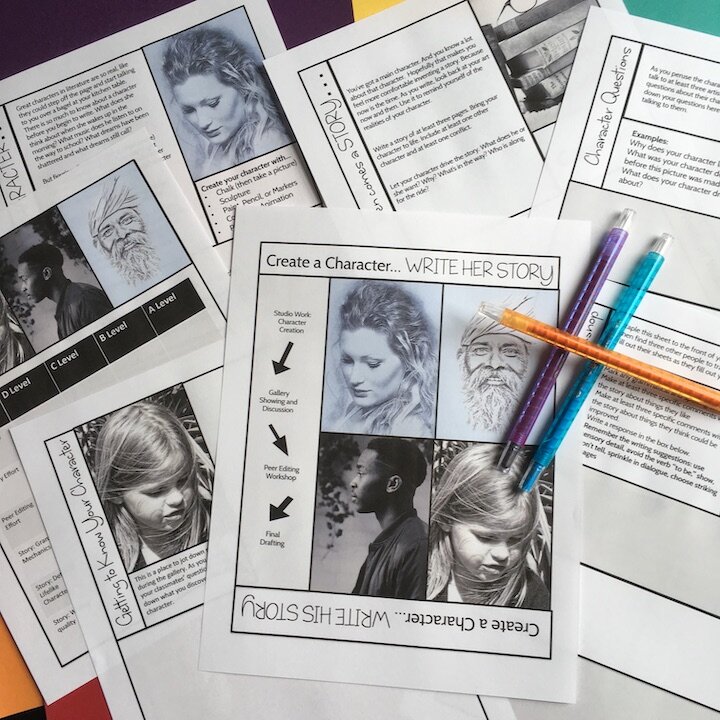
Short Story Maker Space Assignment from Spark Creativity
REFLECTION ACTIVITY
Bespoke ELA’s post is all about the recursive nature of writing. It goes all directions: forward, backward, and sideways. Support secondary writers by teaching them to be reflective throughout the process.
Use these FREE task cards by Bespoke ELA at the end of a Writer’s Workshop to emphasize that an essay can be edited and revised at any time. Communicate to students that writing is a continual, recursive process, not linear.
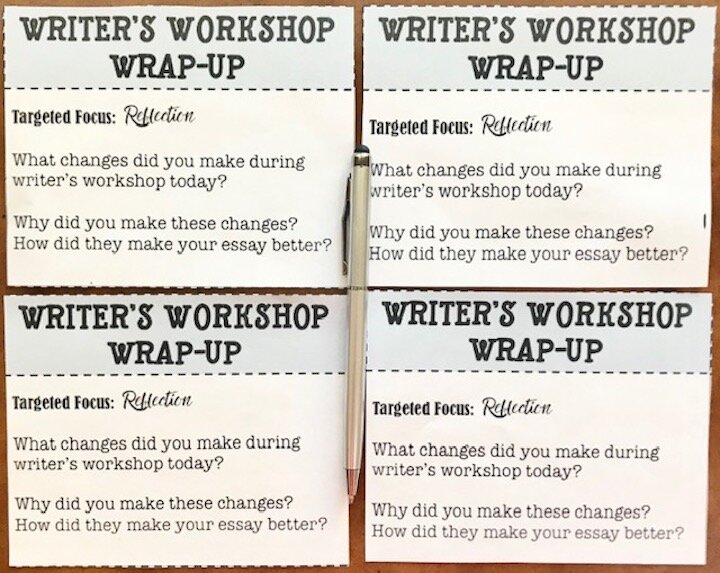
Writing Workshop Wrap-Up Task Cards from Bespoke ELA
CREATIVE WRITING
Teaching a creative writing unit or class? In this post , Language Arts Classroom writes about THREE creative writing assignments you can use with students; how-to articles, children’s books, and movie scripts.
And! Help students organize their writing with a creative angle: cookies! These graphic organizers will help students with brainstorming, narrowing ideas, and more.
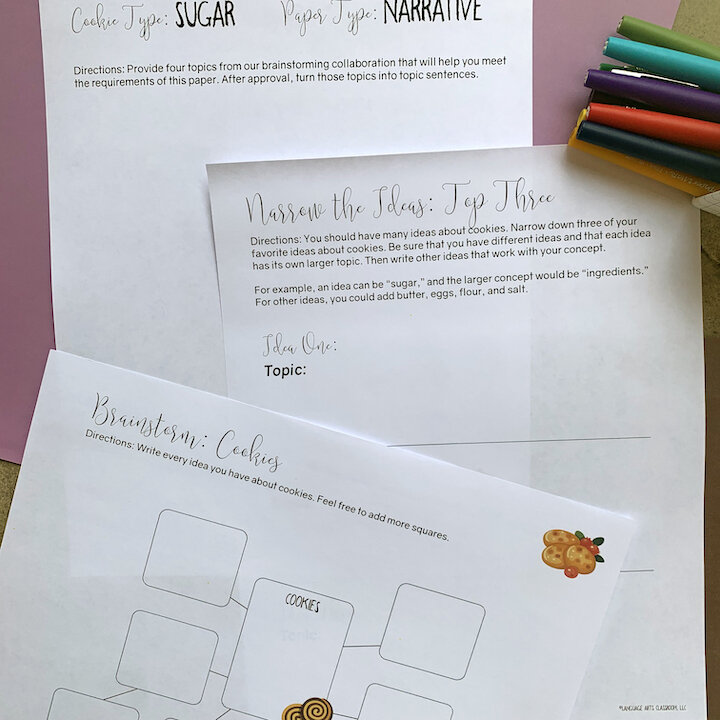
Cookie Organization Graphic Organizers by Language Arts Classroom
WRITING MINI LESSONS
One of the most popular ways to incorporate lessons that inspire secondary writers is writing workshop. The problem? Without training, it’s hard to figure out how to get started.
Amanda Write Now’s post covers various angles to consider when setting up a writing workshop. Specifically, this article features “how-tos” for FIVE of her favorite workshop mini lessons .

Writing Workshop Launch Lessons from Amanda Write Now
related posts:
Are instagram captions a teaching genre, 5 creative reading response activities, 10 unique and creative reflection techniques.

Walking by the Way
the road to inspired learning
Eight Free Creative Writing Lessons
February 17, 2012 by Ami 17 Comments
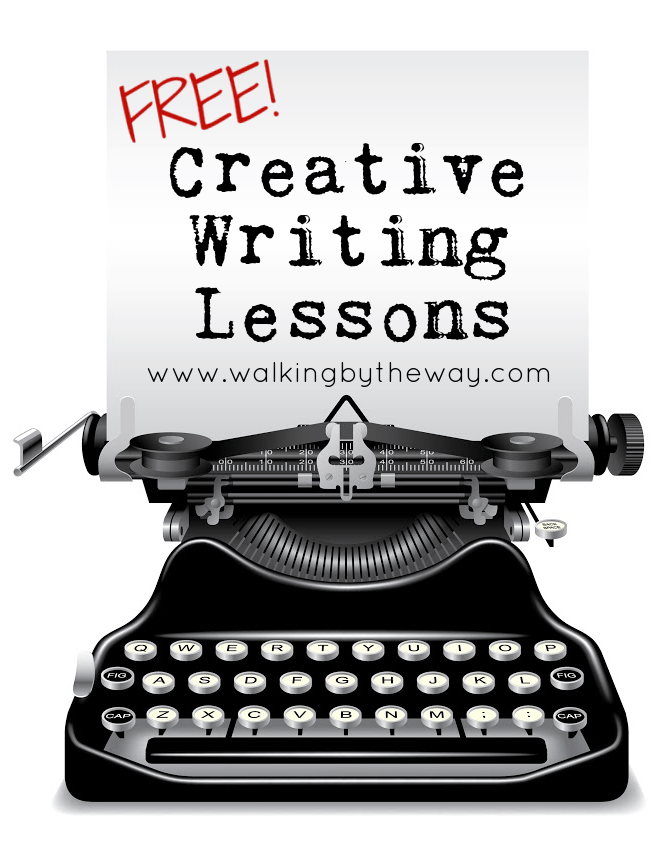
I know I throw around the word favorite all the time. But this is the truth: teaching creative writing lessons is my favorite.
I have taught creative writing enrichment for summer school students. I have taught creative writing in various homeschool settings and co-ops. I have taught big students and little students. And I love it.
Since I love to share homeschool co-op class ideas , I have compiled the creative writing lessons from a co-op class that I taught.
Creative Writing Lessons for a Homeschool Co-op Class
First, please remember that any teacher can use these creative writing lessons. You don’t need to be teaching homeschoolers. You can be a classroom teacher or a homeschool teacher at home with one student. You can even be a librarian who needs a fun program series.
Second, I used these creative writing lesson plans with upper elementary students (with maybe a few 7th graders thrown in). However, you can adapt and use them for older students or younger students!
Creative Writing Lesson Plans
Creative writing lesson one.
The first lesson focuses on cliché and metaphor. It prompts students to consider how words matter.
Grab lesson one here .
Creative Writing Lesson Two
The second lesson teaches students about sensory details: why they are important and how to include them in their writing. Students will begin using sensory details to evoke smells and sounds and sights.
Grab lesson two here.
Creative Writing Lesson Three
The third lesson introduces showing vs. telling. Students learn how to recognize authors who utilize showing, and students are able to articulate the difference between showing and telling.
Grab lesson three here.
Creative Writing Lesson Four
The fourth lesson teaches students how to capture images. We use examples of poetry and prose to discuss this important writing skill.
Grab lesson four here.
Creative Writing Lesson Five
The fifth lesson introduces the story elements of character and conflict.
Note: You may choose to split this lesson into two lessons since it covers two big elements. I only had nine weeks with my students, so I had to jam character and conflict together.
Grab lesson five here.
Creative Writing Lesson Six
The sixth lesson introduces the students to point of view and perspective. We have fun reading poems and using pictures to write descriptions from different points of view.
Grab lesson six here.
Creative Writing Lesson Seven
The seventh lesson puts everything we’ve learned together. I read the students some fractured fairy tales, and we watch some, too. Students then use the prewriting activities and their imaginations to begin drafting their own fractured fairy tales.
Grab lesson seven here.
Creative Writing Lesson Eight
The eighth lesson focuses on revision. After a mini-lesson, students partner up for peer editing.
Grab lesson eight here .
For our final class day, students bring revised work, and I host coffee shop readings. This is a memorable experience for students (and their teacher).
Creative Writing Lessons FAQ
Since posting these creative writing lessons, I have had lots of questions. I decided to compile them here in case you have the same question.
Q: What are copywork quotes? A: Copywork quotes are simply great quotes that students copy as part of their homework assignments. You can use any quotes about writing. I’ve included my favorites throughout the printable packs.
Q: Can I use this with a younger or older student? A: Absolutely! Just adapt it to meet the needs of your student.
Q: Can I use this for my library’s programming or my homeschool co-op class? A: Yes! I just ask that it not be used for profit.
Do you have any questions about teaching creative writing? What’s your biggest hang-up when it comes to teaching creative writing? I’d love to hear from you and help you solve the issue.

January 7, 2016 at 1:57 pm
Hi Theresa,
As long as you are not profitting from using them, they are yours to use! Enjoy! Wish I could be there to help facilitate all those young writers!
[…] Creative Writing Class […]
Leave a Reply Cancel reply
Your email address will not be published. Required fields are marked *
Save my name, email, and website in this browser for the next time I comment.
Purdue Online Writing Lab Purdue OWL® College of Liberal Arts
Welcome to the Purdue Online Writing Lab

Welcome to the Purdue OWL
This page is brought to you by the OWL at Purdue University. When printing this page, you must include the entire legal notice.
Copyright ©1995-2018 by The Writing Lab & The OWL at Purdue and Purdue University. All rights reserved. This material may not be published, reproduced, broadcast, rewritten, or redistributed without permission. Use of this site constitutes acceptance of our terms and conditions of fair use.
The Online Writing Lab (the Purdue OWL) at Purdue University houses writing resources and instructional material, and we provide these as a free service at Purdue. Students, members of the community, and users worldwide will find information to assist with many writing projects. Teachers and trainers may use this material for in-class and out-of-class instruction.
The On-Campus and Online versions of Purdue OWL assist clients in their development as writers—no matter what their skill level—with on-campus consultations, online participation, and community engagement. The Purdue OWL serves the Purdue West Lafayette and Indianapolis campuses and coordinates with local literacy initiatives. The Purdue OWL offers global support through online reference materials and services.
Social Media
Facebook twitter.
- International
- Education Jobs
- Schools directory
- Resources Education Jobs Schools directory News Search

Euro 2024 Germany Ideas and Lesson / Medium Term plans Primary EYFS KS1 KS2
Subject: Geography
Age range: 7-11
Resource type: Unit of work
Last updated
9 June 2024
- Share through email
- Share through twitter
- Share through linkedin
- Share through facebook
- Share through pinterest

This bundle includes:
Creative ideas for Euro 2024 activities in EYFS, Year 1, 2, 3, 4, 5 & 6 including continuous provision. Some ideas do overlap!
Medium Term plan overview (6 lessons) about Germany (geography, history and major sporting events)
Lesson Plan for each of the 6 lessons
2 x Knowledge organisers
2 x Germany Euro 2024 comprehensions
5 x science investigation ideas (not necessarily related to NC Curriculum!)
Hope it helps! :)
**WANT TO PLAY A SIMPLE EURO 2024 FANTASY FOOTBALL GAME WITH YOU CLASS/SCHOOL? Click below to see my fantasy football game! :) **
https://www.tes.com/teaching-resource/-13054533
Tes paid licence How can I reuse this?
Your rating is required to reflect your happiness.
It's good to leave some feedback.
Something went wrong, please try again later.
This resource hasn't been reviewed yet
To ensure quality for our reviews, only customers who have purchased this resource can review it
Report this resource to let us know if it violates our terms and conditions. Our customer service team will review your report and will be in touch.
Not quite what you were looking for? Search by keyword to find the right resource:

IMAGES
VIDEO
COMMENTS
This resource covers the integral, surface and deep features of creative writing. It contains full-on activities and assessments to cover the skills of literacy in an easy, structured, cover-your-bases system. It includes everything you need to get going with Creative Writing in your classroom. This Resource Includes: 1. A Detailed Lesson Plan. 2.
Lessons and activities. Creative and descriptive writing is a great opportunity for students to explore different themes, audiences and purposes as well as demonstrate their understanding of how structure and punctuation can be used to impact a reader. From creative writing prompts to technique booklets and descriptive writing planning mats, we ...
A short 5 lesson unit on Imaginative/Creative writing, created for the new GCSE English Language 9-1 spec. Contains lessons on describing setting and character, effective story openings, narrative structure (using The Simpsons) and the importance of planning. Clear assessment and success criteria checklists, which could be used for self/peer ...
Creative writing lesson plans and classroom materials from Tes gives you the tools you need for engaging high school lessons for English language arts. International; ... Tes Global Ltd is registered in England (Company No 02017289) with its registered office at Building 3, St Paul's Place, Norfolk Street, Sheffield, S1 2JE ...
Subject: English. Age range: 7-11. Resource type: Lesson (complete) File previews. pptm, 1.96 MB. A fun and simple lesson to get your KS3 Pupils into their creative zone. Creative Commons "Sharealike".
Subject: English. Age range: 11-14. Resource type: Lesson (complete) File previews. pdf, 2.06 MB. pdf, 360.29 KB. pptx, 13.18 MB. docx, 965.48 KB. Make the most of this year's Euros with these fun and engaging football focused creative writing resources, based around and inspired by the European Championships in Germany!
An easy lesson plan for creative writing that will pay off later is to activate prior knowledge. Brainstorm creative, memorable, unforgettable stories with students. Share your thoughts too! You will start to build relationships with students who share the same tastes as you (and those that are completely different!).
Creative writing. Browse this rich collection of English teaching resources, teaching ideas, templates and creative writing lessons to develop students' descriptive writing, narrative writing and creative writing skills. You'll find compelling picture prompts, supportive word banks and carefully scaffolded resources to engage even the most ...
A flexible creative writing lesson plan supports all the writing genres, from narratives to poetry (and everything in between!). Whether you're looking for quick, usable ideas to help your students compose stories, biographies, personal or business letters, reviews and editorials, essays or poetry, browse through the links below.
Giving students time for thinking and the creation of ideas is essential. Therefore, this plan should be seen as just a starting point; it provides the stimulus from which a number of sessions can be developed. Subsequent periods can also focus on the development of different writing skills as required by the individual needs of a group.
National Writing Day is an annual day dedicated to celebrating and practising creative writing for pleasure and self-expression. These resources could be used to celebrate National Writing Day ...
The "I Remember" Poem. Students use personal experience to write creatively in this poetry lesson plan. They'll think back and choose a dozen…. Subjects: Reading and Literature. Poetry. Creative Writing. Download. Add to Favorites.
Creative writing is, as you might expect, the art of writing creatively! It's also known as Narrative Writing. Usually, it is the act of writing a fictional story with a structure, using knowledge of spelling, punctuation and grammar to set it out correctly. But, creative writing can also be in the form of poetry, scripts, or fictional ...
6 Ways to Teach Writing reatively Teach your students the fun aspects of writing. Students of all ages write short stories and papers, from younger elementary-school writers through college-age students.
Creative Writing. Subject: English. Age range: 11-14. Resource type: Lesson (complete) MissLMLovatt. 4.60 290 reviews. Last updated. 20 September 2016. Share this. Share through email; Share through twitter; ... Tes Global Ltd is registered in England (Company No 02017289) with its registered office at Building 3, St Paul's Place, Norfolk ...
Content Area:English as a second language. Procedure: 1. Introduction on creative writing is to be given to students as they have no previous knowledge of the topic. 2.As a warm up activity, students will be asked to attempt free writing on a given topic. This will create confidence in them that they can attempt writing tasks.
Enhance your There Will Come Soft Rains lesson plans with these captivating and thought-provoking creative writing prompts. Ideal for a variety of class activities, including starter tasks, homework assignments, writing assessments, and substitute teacher lessons, these prompts will challenge your students to explore the characters, themes, and concepts presented in the short story.
Mysteries are a great way to hook students into writing about fictional happenings. In this lesson, students engage themselves in The Mysteries of Harris Burdick by examining the illustrations in the book and choosing one for which to create a Mystery Cube and then a creative writing piece.Finally, students present their mysteries to the class and allow students to guess to which illustration ...
Dive into a spooky-type short story and character analysiswith "The Most Dangerous Game.". "Most Dangerous Game" Character Analysis Workbookfrom Teach BeTween the Lines. MAKER SPACE. This creative lesson to inspire secondary writers is a newer approach. Turn your writer's workshop into a maker spacewith these unique ideas from Spark ...
First, please remember that any teacher can use these creative writing lessons. You don't need to be teaching homeschoolers. You can be a classroom teacher or a homeschool teacher at home with one student. You can even be a librarian who needs a fun program series. Second, I used these creative writing lesson plans with upper elementary ...
8. Out of a Hat. Teach your students about the components of different literary forms by discussing writing styles (narrative, expository, descriptive, and persuasive). Write each form on a small piece of paper and, you guessed it, toss it in a hat (or a bucket or any type of container).
pdf, 17.69 MB. This Amazing ESL-EFL-TESOL Lesson Plan (PDF Digital Presentation; 13 slides + Answer keys in the last slide) on Antarctica is Great to stimulate English Learning within Newcomers or any English Second Language Student. Ideal participants for this Activity are Foreign Languages Students at Middle School and High School.
KS2 Creative Writing for Yr 4/5/6. Subject: English. Age range: 7-11. Resource type: Lesson (complete) File previews. zip, 3.33 MB. Powerpoint and worksheets for KS2 creative writing lessons. The tasks are designed to help students improve their creative writing. There is a task on developing characters, writing dialogue, describing emotions ...
The Online Writing Lab (the Purdue OWL) at Purdue University houses writing resources and instructional material, and we provide these as a free service at Purdue. Students, members of the community, and users worldwide will find information to assist with many writing projects. Teachers and trainers may use this material for in-class and out ...
From critical thinking and creative problem solving to communication and collaboration, Adobe Creative Cloud helps students build the skills they need to succeed in K-12, higher education, and the modern workforce. Adobe Creative Cloud for education provides educational institutions with industry-leading creative tools and centralized ...
Students and Teachers. Introductory Pricing Terms and Conditions Creative Cloud Introductory Pricing Eligible students 13 and older and teachers can purchase an annual membership to Adobe® Creative Cloud™ for a reduced price of for the first year. At the end of your offer term, your subscription will be automatically billed at the standard subscription rate, currently at (plus applicable ...
1 Speaking Game (Interview and Singer interview) with 12 Flashcards with prompts to help the "interviewer" develop the questions. 1 Song Activity ("Love Love Peace Peace" by Mans Zemerlow and Petra Mede) with Worksheet (QR Code-Linked Song) with lyrics with missing words and sentences to fill. 1 Writing activity with 3 Prompts for Essay.
CapCut pour ordinateur prend en charge le montage vidéo complexe avec des performances stables et une interface conviviale. Télécharge l'application pour ordinateur et commence à créer tes projets. Capture des moments inoubliables et crée à la volée. Coupe, découpe et monte des vidéos avec l'application CapCut pour enregistrer et ...
This bundle includes: Creative ideas for Euro 2024 activities in EYFS, Year 1, 2, 3, 4, 5 & 6 including continuous provision. Some ideas do overlap! Medium Term